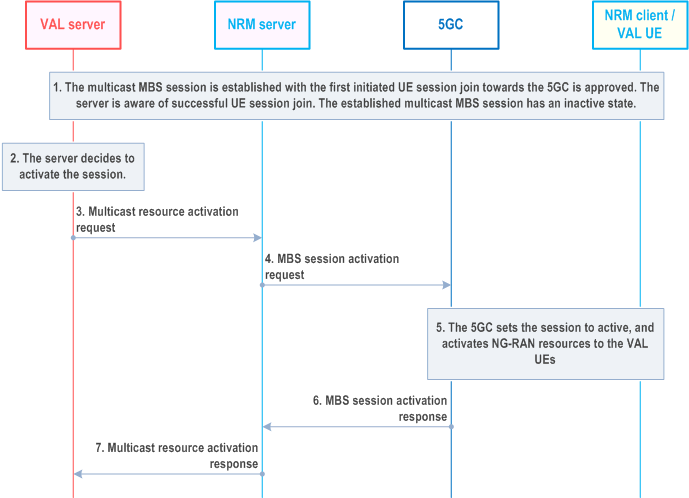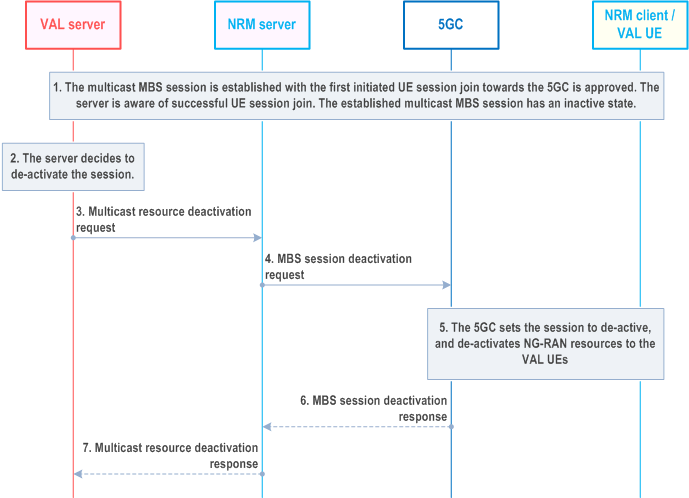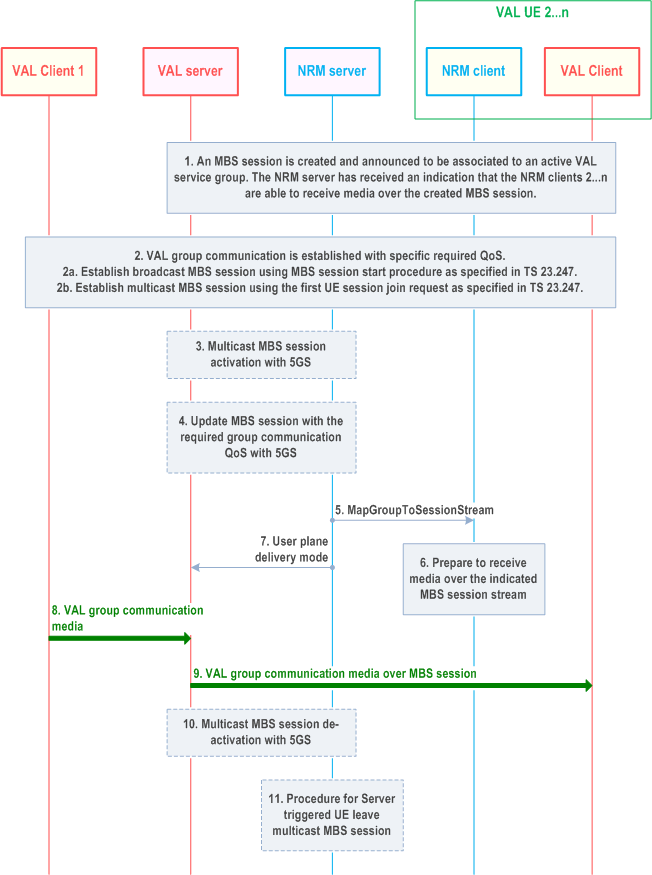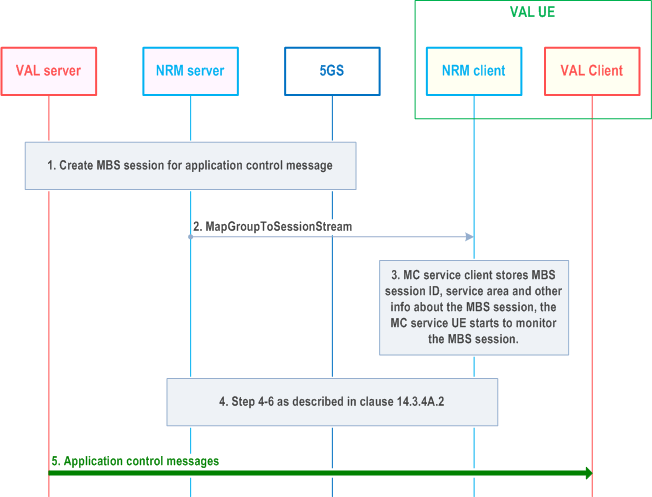Content for TS 23.434 Word version: 19.4.2
0…
6…
8…
9…
9.3…
9.3.3…
9.3.8…
9.3.13…
9.3.20…
9.3.23…
9.4…
10…
10.3…
10.3.3…
10.3.7…
10.4…
11…
12…
13…
14…
14.3…
14.3.3
14.3.4
14.3.4A…
14.3.4A.5…
14.3.4A.8…
14.3.5…
14.3.9…
14.4…
15…
17…
18…
A…
14.3.4A.5 Request to activate / de-activate multicast MBS sessions
14.3.4A.6 VAL service group media transmissions over 5G MBS sessions
14.3.4A.7 Aplication level control signalling over 5G MBS sessions
...
...
14.3.4A.5 Request to activate / de-activate multicast MBS sessions p. 264
14.3.4A.5.1 General p. 264
In case of multicast MBS sessions, the members affiliated to a certain VAL service group need to initiate a UE session join request towards the 5GC in order to receive the VAL media sent via the associated MBS session. The UE session join request enables the reservation of NG-RAN resources for the members of the VAL group. However, it is not necessary that the VAL media is delivered over the whole time the multicast MBS session is associated to the group under consideration. Therefore, the VAL server is able to efficiently utilize and control the reservation of radio resources based on the availability of VAL data to be delivered via the activation and de-activation procedure with NRM server. This presents more flexibility and efficient use of resources different from LTE.
The most suitable scenario to activate/de-activate a certain multicast MBS session is based on whether there is a VAL group communication, taking place over that associated session to the VAL service group. In this manner, the VAL server can activate the associated multicast session once a VAL group communication takes place, then deactivate it once the VAL group communication is over. Whether the multicast session is activated (i.e., in an active state), or de-activated (in an inactive state), the VAL group is associated to the multicast session and its members are within a UE session join.
The activation or de-activation request is initiated by the VAL server towards the NRM server which further interacts either directly with the MB-SMF or indirectly with NEF/MBSF.
14.3.4A.5.2 Multicast MBS session activation procedure p. 264
The procedure shown in Figure 14.3.4A.5.2-1 presents the multicast MBS session activation procedure initiated by the VAL server.
Pre-conditions:
- NRM clients are attached to the 5GS, registered and affiliated to the same VAL service group X.
- The NRM server has directly performed (or via NEF/MBSF) an MB-SMF discovery and selection, unless the corresponding information is locally configured.
- The multicast MBS session for NRM group communications associated to VAL service group X.
- The MBS session is created and announced to address VAL group communication related to the associated VAL service group X with certain service requirements and optionally with a certain service area.

Step 1.
The multicast MBS session is established as the first UE session join request, which is initiated by the first VAL UE towards 5GC, is granted. At this stage, the multicast MBS session is established with an inactive state.
Step 2.
The VAL server decides to activate the multicast MBS session as VAL data is needed to be transmitted over the session to the VAL service group X, as a VAL group communication is to take place over the associated MBS session.
Step 3.
The VAL server invokes the multicast resource activation request provided by NRM server, the MBS session ID is included.
Step 4.
Upon receiving the request in step 3, the NRM server sends an MBS session activation request towards the 5GC, either directly to the MB-SMF or via NEF/MBSF, indicating the TMGI to be activated.
Step 5.
The 5GC changes the session status to "active" and finds the list of joined VAL UEs associated with the session and activates the NG- RAN resources for VAL data delivery.
Step 6.
The 5GC may send an MBS session activation response to the NRM server indicating that the requested multicast MBS session has been activated.
Step 7.
The NRM server returns the multicast resource activation response to the VAL server.
14.3.4A.5.3 Multicast MBS session de-activation procedure p. 265
The procedure shown in Figure 14.3.4A.5.3-1 presents the multicast MBS session activation procedure initiated by the VAL server.
Pre-conditions:
- NRM clients are attached to the 5GS, registered and affiliated to the same VAL service group X.
- The NRM server has directly performed (or via NEF/MBSF) an MB-SMF discovery and selection, unless the corresponding information is locally configured.
- A multicast MBS session is created and announced to address the corresponding VAL service group with certain service requirements and optionally with a certain multicast service area.
- The VAL UE have already joined the multicast MBS session and are able to receive the VAL data over the associated MBS session.

Step 1.
The group communication associated with VAL service group X takes place, and the corresponding VAL data is delivered over the associated multicast MBS session, hence the MBS session has an active state.
Step 2.
The VAL server decides to deactivate the multicast MBS session, as no further VAL data to be delivered to the associated group, or the VAL group communication is over, and no further VAL media is to be delivered.
Step 3.
The VAL server invokes the multicast resource deactivation request provided by NRM server, the MBS session ID is included.
Step 4.
Upon receiving the request in step 3, the NRM server sends an MBS session deactivation request towards the 5GC, either directly to the MB-SMF or via NEF/MBSF, indicating the TMGI to be deactivated.
Step 5.
The 5GC changes the session state to "inactive" and deactivates the radio resources associated with the joined VAL UEs.
Step 6.
The 5GC may send an MBS deactivation response to the server indicating that the requested multicast MBS session has been inactivated.
Step 7.
The NRM server may return the multicast resource deactivation response to the VAL server.
14.3.4A.6 VAL service group media transmissions over 5G MBS sessions p. 266
14.3.4A.6.1 General p. 266
The VAL server can decide to configure an MBS session per VAL service group to transmit the media related to the corresponding VAL group communications. Such group communications can comprise different service requirements. For that, multicast and broadcast MBS sessions need to be configured with multiple MBS QoS flows to address different service requirements, e.g., different required QoS, provided by the NRM server. For instance, application-level control messages or media associated to a group communication can comprise different QoS requirements. Also, different type of group communications can comprise different QoS requirements, e.g., emergency group communication should be handled with a higher priority than normal group communication.
The configuration of multiple MBS QoS flows to address different service requirements is associated to the assignment of different streams (e.g., different ports) within an MBS session.
The established multicast MBS session can either be in active or inactive state, where the former indicates the activation of radio resources hence transmitting the VAL media to the associated VAL service group, and the latter indicates their deactivation as no VAL media is being transmitted. The VAL server may initiate the activation of multicast MBS sessions once the VAL service group is established and active, as well as once the VAL media is available for transmission. For this purpose, the VAL server sends a multicast MBS session activation request towards the NRM indicating the MBS session ID to be activated, and the NRM server further interacts with the 5GS to complete the MBS session activation.
Similar to the use of eMBMS, the NRM server shall provide the associated information between a specific group communication and the stream to be used within an MBS session to the UE. This information could be sent in advance in an MBS session announcement or could be provided on demand in an additional signalling message for the MBS session, e.g., MapGroupToSessionStream (similar to the MapGroupToBearer in eMBMS).
14.3.4A.6.2 Procedure p. 267
The procedure in Figure 14.3.4A.6.2-1 describes how media related to a specific group communication can be distributed over a configured MBS session which consist of multiple QoS flows, i.e. addressing different service requirements. The procedure is applicable for both the pre-created MBS session case as described in 14.3.4A.2.2 and the dynamic MBS session case as described in 14.3.4A.2.3. For simplicity, the Figure 14.3.4A.6.2-1 shows that the MBS session is pre-created prior to the group communication establishment.
Pre-conditions:
- VAL UE 1 to n are attached to the 5GS, registered and belong to the same VAL service group X.
- The VAL server has decided to use an MBS session for VAL service group communications associated to VAL service group X.

Step 1.
The VAL server creates a multicast or a broadcast MBS session targeting group communications associated to VAL service group X via the NRM server, as being specified in clause 14.3.4A.2. Therefore, the VAL server can provide default service requirements to be addressed by the MBS session.
The MBS session is announced by NRM server and received by NRM client 2 to n. The NRM server has identified that VAL UE 2 to n can receive media over the MBS sessions, e.g. based on a notification from NRM clients indicating the successful join of the multicast MBS session or a monitoring report of the broadcast MBS session (similar to the listening status report used for MBMS).
Step 2.
A new VAL group communication is established for the VAL service group X consisting of a specific required service requirements, e.g. a VAL service emergency group communication. The group communication setup can be done over unicast.
Step 2a.
For broadcast MBS sessions, the session is established as described in TS 23.247.
Step 2b.
For multicast MBS session, the session is established upon the acceptance of the first UE session join request initiated from the VAL UE towards the 5GS, as described in TS 23.247. The multicast session can then have either an active or an inactive state.
Step 3.
The VAL server may initiate the multicast MBS activation towards the NRM as described in clause 14.3.4A.5 in order to activate the multicast MBS session in case the session has an inactive state.
Step 4.
Considering that the established group communication requires a specific QoS, e.g. an VALemergency group communication which requires higher priority (i.e. better ARP), the VAL server initiates an MBS session update to the NRM to provide the new required service requirements, if not done during the MBS session creation in step 1, as described in clause 14.3.4A.2. The MBS session should then be updated and an additional QoS flow may be configured.
Step 5.
The NRM server sends a MapGroupToSessionStream to NRM clients 2 to n over the configured MBS session providing the required stream information to receive the media related to the specific established VAL group communication within the MBS session.
Step 6.
NRM clients process the MapGroupToSessionStream information to receive the related media over the specific MBS session stream.
Step 7.
The NRM server sends the user plane delivery mode message to the VAL server to instruct the VAL server to switch to MBS delivery.
Step 8.
VAL client 1 sends media to the VAL server over unicast to be distributed for the established group communication.
Step 9.
The VAL server distributes the media to VAL clients 2 to n over the indicated stream within the established MBS session.
Step 10.
The VAL server may initiate the multicast MBS session deactivation towards the NRM as described in clause 14.3.4A.5, in order to deactivate the multicast MBS session.
Step 11.
The NRM server may further trigger the UE to leave multicast MBS session.
14.3.4A.7 Aplication level control signalling over 5G MBS sessions p. 269
14.3.4A.7.1 Description p. 269
The VAL server may use an 5G MBS session for application level control signalling. An 5G MBS session for application level control signalling is typically used for the purposes beyond the benefit for using 5G for resource efficiency, e.g. for improved MC service performance (KPIs), handling of high load scenarios.
Similar to the usage of eMBMS, both broadcast and multicast 5MBS session for application level control signalling may be used to transmit the following messages, for example:
- MBS session announcement for media sessions
- Group application paging
- Group dynamic data (e.g. status of the group)
14.3.4A.7.2 Procedure p. 269
The procedure in Figure 14.3.4A.7.2-1 shows only one of the receiving VAL UE using a 5G MBS session.

Step 1.
The VAL server determines to create MBS session for application-level control signalling, the VAL server initiated the 5G MBS session establishment via the NRM is done according to clause 14.3.4A.2.
Step 2.
The NRM server passes the 5G MBS session info for the service description associated with the 5G MBS session to the NRM client. The NRM client obtains the MBS session ID, from the service description.
Step 3.
The NRM client stores the information associated with the MBS session ID. The NRM client uses the MBS session ID and other 5G MBS session related information to enable monitoring of the 5G MBS session by the VAL UE.
Step 4.
Steps 4 to 6 defined in clause 14.3.4A.2 are performed.
Step 5.
The VAL server transmits MC application control messages over the MBS session.